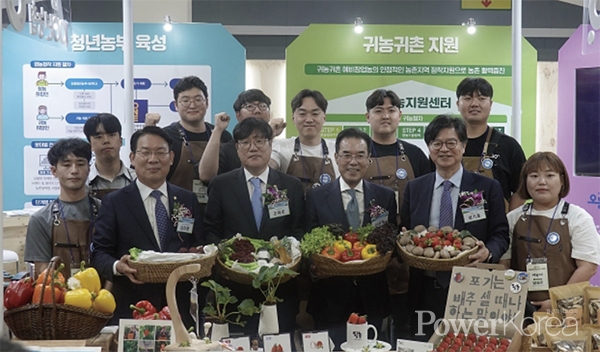 |
||
| ▲ Sunmiwon Farm / CEO Farmer Lee Sae-hoon | ||
Paprika accounts for about 70% of Goseong-gun’s total agricultural exports, twenty farmers producing on 36 hectares. Sunmiwon Farm CEO Farmer Lee Sae-hoon runs a paprika farm the size of two football fields. Lee says “I originally wanted to do interiors, so I studied architecture in Australia for two years. Then my visa expired and I came back to Korea, but the pandemic made it difficult to start a business. The paprika my parents were exporting to Japan was also locked down, so I ended up becoming a farmer.”
 |
Goseong-gun has the perfect environment for growing paprika, with its large, fertile land and proximity to the sea. Paprika grown in the sea breeze has a good sugar content, 90% water content, a thick and crunchy texture, and a sweetness similar to watermelon. Lee says “Paprika is high in vitamin C, which moisturizes the skin. It’s best when eaten raw because vitamin C is vulnerable to heat.” Red paprika is high in beta-carotene, which is great for boosting the immune system, yellow has an anti-clotting compound called paragine, which helps reduce skin inflammation, and orange is rich in vitamin A, phosphorus, and potassium, which is great for eye health.
 |
Growing paprika in a smart farm in Goseong
Paprika needs to grow in an environment of 18~21﹎ all year round. For this reason, paprika is mostly grown in smart farm facilities in Korea. Lee says “The smart farm takes care of maintaining the temperature and humidity and feeding the plants. You set the desired temperature and the system turns on the heat and draws the heat curtains. Paprika is a crop that is 90% water, so it absorbs a lot of water right up until harvest, and we have to feed it 18 times a day with a culture mixed with various minerals. Through pipes laid across the field, the nutrient solution is delivered in a timed system. The amount of water we use at any one time is five tons.” Plant seeds in a nursery field in early August, grow the seedlings for two weeks, transfer them to medium in the main field, support them for a couple of months, and the stems will grow to thigh height, and if you place hives around them, they will produce fruit on their own. The fruit cycle usually lasts seven to eight weeks, and you can harvest twice a week from December through July.
 |
The stems grow quickly and need to be trimmed every one to two weeks to remove the lower leaves, prune, and harvest. Lee entered the Young Farmers Academy in the first half of 2022 and graduated with the first grade. For his contribution to the industry, he received the Young Farmer of the Year Together 2023. Lee says “The land never lies, and if you farm with honesty and sweat, you will be rewarded”
김태인 기자 red3955@hanmail.net







